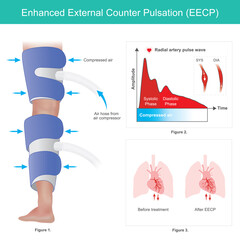
Angioplasties and Bypass surgeries are the most common treatments to widen narrowed blood vessels and improve blood circulation for people with angina and blockages in the heart. However, some people may be unfit for angioplasty, such as those who have obstructions in arteries that run the length of the artery and are clogged with fatty plaques. Even if it is attempted, the chances of it happening again are very high. The chances of recurrence increase with each procedure for people who have had multiple procedures.
Thus, an alternative such as EECP (Enhanced External Counterpulsation) is recommended for such people.
Let’s discuss the BENEFITS of EECP over BYPASS or ANGIOPLASTY surgeries:
Bypass Surgery (shortcomings) | Angioplasty (shortcomings) | Benefits of EECP |
This is not a permanent cure for angina or blockages, which is why people must undergo multiple bypass surgeries over the course of their lives. | Plaque is not removed during Angioplasty, but it is compressed within the arteries to allow blood flow. | One of the greatest benefits of EECP is that it removes plaque from the coronary arteries without invasive surgeries. |
Plaque is not removed during bypass surgery, but a path is manually created to allow blood to flow to other parts of the heart muscles. Coronary Bypass Surgery will not be able to revive or make alive damaged or dead heart tissues or muscles. | Even after treatment, the problem may recur every 2 months to 2 years. | It opens thousands of new collateral (thin arteries) in the heart and other vital organs of the human body, effectively creating redundancy within the human body. These new collaterals provide multiple pathways for fresh blood flow in various parts of the heart muscle. These new collateral create a natural ‘bypass’ in the Coronary Arteries without causing any damage. |
In general, the problem recurs within 6 months to 5 years. In thin arteries, bypass surgery is not possible; patients must live with critical blockages for the rest of their lives. | Inside the thin arteries, angioplasty is clinically impossible; patients live with such critical blockages in the thin arteries for the rest of their lives. | Because of the fresh blood flow through these new collateral tubes, the area of damaged or dead heart muscles begins to work on developing new tissues. |
The affected area in the coronary arteries re-blocks at a rate of 10% to 20%, which is about 10 times faster than a natural process. | Coronary Angioplasty cannot bring damaged or dead heart tissues or muscles back to life. | Improvement in the ‘LVEF (Left Ventricular Ejection) factor’ – the heart’s ability to pump blood. |
In most cases of coronary angioplasty, a stent is not inserted in blockages less than 70%, so all blockages less than 70% remain untreated in the coronary arteries. | The affected area in the coronary arteries re-blocks at a rate of 10% to 30%, which is about 15 times faster than the natural artery. | This treatment is regarded as a miracle for patients who are living their lives after a HEART ATTACK, regardless of whether they underwent Angioplasty or Bypass Surgery. |
Patients must take their medications on a regular basis throughout their lives, and the dosages of the medications increase over time. | In most cases of coronary angioplasty, a stent is not inserted in blockages that are less than 70%, so all blockages that are less than 70% remain in the coronary arteries. | Benefits of EECP also include increased blood flow in the heart and other vital organs of the body by 25% to 50%, which improves the health of all those organs and regulates blood sugar levels phenomenally, lowering blood pressure. Patients are at ease and optimistic about their lives; they FEEL healthy. |
Unlike the benefits of EECP, the ability to live a normal life after bypass surgery is always a topic of debate among cardiologists. | Patients must take their medications on a regular basis throughout their lives, with the dosages increasing over time. | Patients benefit greatly in the majority of curable and non-curable diseases, such as brain stroke, metabolic syndrome, chronic kidney disease (CKD), disease in the lymphatic syndrome, erectile dysfunction (or impotence), and peripheral arterial diseases (blockages in the lower extremities). |
Bypass surgery is used to treat coronary artery disease that has progressed over the course of 30 to 50 years. | Angioplasty is a temporary and expensive solution, and people need to undergo repeated angioplasties throughout their lives for clearing the arterial blockage. So, if you compare it with the benefits of EECP, it is much lesser beneficial. | Talking more about the benefits of EECP – the need for medicines after treatment is minimal, if not non-existent. |
What do RESEARCH STUDIES say?
Recently, European Heart Journal conducted a study to assess the effects of the enhanced external counterpulsation post-Covid 19. It was found that 66% of them had no heart failure symptoms post-treatment. 84% of treatment group participants had sustained NYHA class improvement at half a year follow-up. It was concluded that Enhanced external counterpulsation (EECP) therapy sustainably improves NYHA functional class and LVEF in patients with ischemic CHF exacerbation after COVID-19.
Furthermore, Frontiers in Cardiovascular Medicine (Indonesia) in one of their clinical trials aimed at studying whether or not External counterpulsation (EECP) provides long-term benefits of improved anginal frequency and exercise tolerance in patients with refractory angina. After a 35-hour EECP session, it was observed that conditions like Diabetes mellitus, hypertension, dyslipidemia, and family history of CAD proportions were more than half encountered in patients. Furthermore, no major adverse cardiovascular events were observed during the study period.
Not only this, but also the American College of Cardiology, in one a small study of long COVID-19 patients, found out that after 15-35 hours of enhanced external counterpulsation (EECP) therapy, patients with and without coronary artery disease improved a variety of symptoms, including fatigue, breathing difficulties, and chest discomfort.
Thus, we may say that the ongoing studies and observations pretty much coincide with the positive outcomes of EECP treatment in Heart diseases which clearly shows that EECP is probably the future of treatment in cardiovascular disorders.
At Poona Preventive Cardiology Center, we provide the safest and most clinically approved non-surgical treatments for cardiovascular diseases with our team of heart specialists and state-of-the-art facility. Our EECP treatment for heart block uses a series of blood pressure cuffs on both legs as part of our Preventive Cardiology treatments. It creates pressure on the blood vessels in the lower limbs in a gentle yet firm way that increases the blood flow to the heart. Our patients have significantly derived benefits of EECP and have experienced relief from heart block symptoms, and were able to resume their normal activities in no time.
Contact us today for non-invasive heart treatments.


